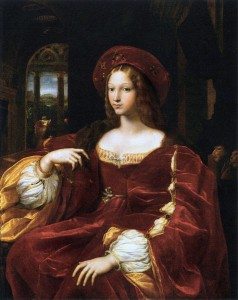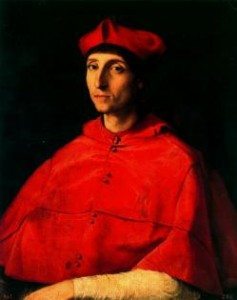The picture of this lady from the Renaissance period was given as a gift to Francis I, King of France, by Cardinal Bibbiena, on behalf of the Medici Pope Leo X, who had earlier instructed Raphael to do several religious painting in order to give them to the monarchs with the intention of persuading the monarchs to join in the war with the Turks.

When you first enter into the last room of the exhibition, you are faced with the Portrait of Cardinal Bibbiena and this delicate lady. One of the first things you might notice is how the two are positioned within the portrait, it looks as though one the two are talking to each other. Why did the Cardinal choose this portrait to give to the King?
Bibbiena was an educated manand was sent by the Pope to the French court for the same reason. He realized that he liked Francisco´s portraits of women (it is possible that he bought Leonardo´s work of the Mona Lisa) and for that reason he commissioned a portrait of a beautiful lady that would play favorably with the rest of the female portraits in the royal collection. He thought that this piece would perfectly to complete the king´s collection
Who was this beautiful woman, sung by the poets of her time and whose beauty continues to capture our attention?
Isabel de Requesens and Enriquez (1498-1534 other dates 1500-1539) who was the Countess of Palamos, wife of Don Ramon Cardona, viceroy of Naples and the two Sicilies and main supporter of the interests of Spain in Italy. She was the daughter of Bernat Galcerán Requesens, Earl of Palamos, Catalunya Spain. At eight year of age she was orphaned and heiress of numerous titles and considerable wealth. As was customary of the time, relatives rushed to marry her. The lucky winner was her cousin, Ramón Folch de Cardona III, who was the Anglesola and Baron of Bellpuig, He was thirty years older than the Countess and there was the suspicions that he was the bastard son of The Catholic King Ferdinand I. Despite this suspicious, Ramón came from a very important Catalonian family in the sixteenth-century and was the official Anglesola Cardona and Baron of Bellpuig. He was the founder in 1507 of the Convent of St. Bartholomew in Bellpuig, flamboyant gothic jewel of Renaissance in the county of Urgell.Michale P. Fritz, a Swiss art historian,professor at the University of Freiburg, reveals the story of this painting in a book published in 1997 by the Department of the Louvre painting entitled “The Virreina of Naples”. He explains that there was a mistake, as in the Louvre had confused this lady with Joan of Aragon.
This masterpiece has captured the attention of many people over the centuries including one philosopher, poet and art critic during the nineteenth century, Theophile Gautier. One day, walking throughout the Louvre he stood in front of the portrait and said, ¨I feel jealous of the husband of this beauty¨. Fritz tells us that the lucky husband had two beauties in his life, Isabel and a lover, Eleonora Brogna. Elenoroa was the bridesmaid of Isabel d’Este “whose beauty did not detracted from that of the viceroy “and who was curiously introduced by Isabel to Ramón 1512.
of the husband of this beauty¨. Fritz tells us that the lucky husband had two beauties in his life, Isabel and a lover, Eleonora Brogna. Elenoroa was the bridesmaid of Isabel d’Este “whose beauty did not detracted from that of the viceroy “and who was curiously introduced by Isabel to Ramón 1512.
 of the husband of this beauty¨. Fritz tells us that the lucky husband had two beauties in his life, Isabel and a lover, Eleonora Brogna. Elenoroa was the bridesmaid of Isabel d’Este “whose beauty did not detracted from that of the viceroy “and who was curiously introduced by Isabel to Ramón 1512.
of the husband of this beauty¨. Fritz tells us that the lucky husband had two beauties in his life, Isabel and a lover, Eleonora Brogna. Elenoroa was the bridesmaid of Isabel d’Este “whose beauty did not detracted from that of the viceroy “and who was curiously introduced by Isabel to Ramón 1512. The city of Naples celebrated Isabel´s beauty and characters like the condottiere Francesco d’Avalos, husband of Vittoria Colonna, was smitten with her. There is an anecdote that during a dinner party for Vittoria, her husband put a beautiful pearl necklace on Isabel ( the next day Elizabeth was quick to return to Vittoria Colonna ).Although he was in love with his wife, this story displays the ¨crush¨ that many men in Naples had towards Isabel
No doubt, by the testimony of his contemporaries, that Elizabeth was a great lady who wowed Naples and a great patron of the arts, contributing decisively to the success of their drive against the late Gothic Revival. In her personal life, we know she was widowed in 1522 at the age of twenty-two, and she continued to live in Naples until 1532. Isabel died in 1534 or 1539 and was buried in the church of Santa Anunziatta Neapolitan tomb which disappeared in a fire in 1757.Vasari in his “Life of great artists,” writes Raphael painted only the head, the natural and the rest of the picture was his favorite disciple, Giulio Romano. The scene takes place in 1518, perhaps in the villa of Agostino Chigi in Rome or in the village of Poggio Reale in Naples.
The picture is important because it opens a genre, called “Portrait of chamber” which will have many followers and will reach its full splendor with Titian and Velázquez. So many copies were made that are now scattered throughout different palaces in Europe. Alfonso d’Este Duke of Ferrara commissioned Raphael to make him a copy of a German princess wearing the same dress as Isabel in this portrait.
With a special love to my friend Hasan Niyazi RIP